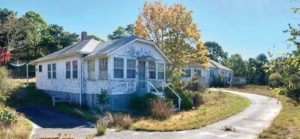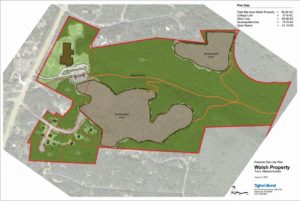TRURO — Three and a half years after the town purchased the 69.9-acre Walsh property for $5.1 million, the long-delayed discussion of its potential use for community housing is starting to move forward. On Sept. 27, the select board heard water resources consultant Scott Horsley summarize the conclusions of his hydrological study: that a “cluster/neighborhood wastewater treatment facility” serving new housing on the Walsh land, the nearby Truro Central School, and some existing neighborhood residences “would result in a net water quality improvement compared to existing conditions.”

A report commissioned by the town from the engineering and environmental consulting firm Tighe & Bond and delivered in January 2022 identified 19.7 “developable acres” and recommended preserving 41 undeveloped acres as open space. The remaining acres have structures on them and are already considered to be developed.
Tighe & Bond reported that, based on the site’s contours and elevation, groundwater would be expected to flow northeast to southwest, away from the two North Union Field wells at the northeast corner of the property, which supply 45 percent of Provincetown’s water. “The Project Site’s development potential is affected by the site’s steep topography, location within mapped rare species habitat, and location within a wellhead protection area,” the consultants wrote. The 19.7 acres identified as developable took these considerations into account.
But a third consultant, Thomas Cambareri of Sole Source Consulting in Centerville, has produced his own report, dated Aug. 24, 2022, in which he contests Tighe & Bond’s hydrogeologic analysis. According to Cambareri, “Groundwater from the entirety of the Walsh property flows to the North Union Field wells, in large part due to the pressure exerted on the water table by these high production-rate wells.” His report emphasizes the importance of protecting the Walsh property as a source of water, noting that the Cape Cod Commission has identified it as a “future water supply site for protection under the Regional Policy Plan.”
Cambareri’s report concluded: “Because of the vital reliance on the NUF wellfield for drinking water, the Walsh Master Plan must prioritize the goal of groundwater protection.” It did not include recommendations about developable acreage at the property.
A New ‘Defense Fund’
Unlike Horsley and Tighe & Bond, Cambareri was not hired by the town. He was retained by an organization called the Truro Environmental Defense Fund, which was incorporated in April 2021 and whose website states that it is “a group of concerned Truro citizens” who want to “take action to preserve Truro’s unique environment in the years ahead.” No names of officers, directors, or members are listed on the website.

Documents filed with the Mass. secretary of state’s office show that the president of the Truro Environmental Defense Fund is Joanne Hollander, who was one of the people who sued the zoning board of appeals and developer Ted Malone in an effort to stop the so-called Cloverleaf affordable housing project in North Truro. The treasurer of the group is Laura Kelly of North Eastham, a landscaper who also founded a group called Protect Our Cape Cod Aquifer. The clerk is David Morine of Great Falls, Va. Other directors are Cheryl Best of Truro, a former member of the charter review committee and a vocal opponent of spending town resources on affordable housing, and Daniel W. Holt of New York City. Karen Tosh, a former member of the Truro Planning Board, is listed as the organization’s legal counsel.
Morine is the former head of land acquisition for the Nature Conservancy. He told the Independent this week that, contrary to the documents on file with the state, Brian Boyle is actually the president of the Truro Environmental Defense Fund. “The guy on top of all of this is Brian Boyle,” said Morine. Kelly also confirmed that Boyle was involved. “I originated it with Brian,” she said.
Boyle is an electrical engineer and one of the “Docs for Truro Safe Water,” a group that has aggressively promoted misinformation about water quality standards, particularly those of the Cape Cod Commission. Its members have refused to answer questions from the Independent.
When asked about the Truro Environmental Defense Fund’s motives for hiring its own consultant to evaluate the Walsh property, Morine said, “Fresh water is the biggest issue facing this country at this time.” He added that “this pro-growth attitude without putting water at the top of the list is insane.” Morine said that he has visited Truro “about five times.”
“Is this really what the town wants to do with the property, put more town buildings on it?” said Kelly. “Of course, the town’s going to say yes.” She said putting affordable housing on the site was a question of logistics and of water being “hurt or contaminated — or able to flow.”
Cluster Treatment
The 69.9 acres of the Walsh property include flat uplands on its northern and southern portions; the land is bisected by a steeply sloping ravine. In the southwest corner of the property lies the primary road access, Walsh Way, and a subdivision of eight parcels containing eight cottages, five sheds, and three garages, all built between 1919 and 1940 and not regularly inhabited. The eight smaller parcels contain 12.6 acres between them and adjoin the Truro Central School, which lies on 7.9-acre parcel northwest of the Walsh property.
The Cape Cod Commission and Mass. Dept. of Environmental Protection cap the nitrate-nitrogen concentration in groundwater in wellhead protection areas at 5 milligrams per liter, Horsley told the select board. The current concentration under the Walsh property, according to Cambareri’s report, is between 0.3 and 0.5 milligrams per liter.
Horsley identified the Truro Central School as an ideal site to be hooked into a cluster wastewater system, given that its Title 5 system has a design flow of 3,500 gallons per day. Some nearby residences could also be included in the filtration system.
Horsley served as the consultant for Wellfleet’s 95 Lawrence Road affordable housing development, which was approved by the town’s ZBA on Sept. 22. That project includes a cluster wastewater treatment system that will also treat the Wellfleet Elementary School’s sewage. Horsley describes 95 Lawrence Road as “not only a very needed affordable housing project, but a significant water quality improvement.”
Truro select board Chair Kristen Reed told the Independent that “you can care about housing and water quality at the same time. Some think they’re mutually exclusive.”



